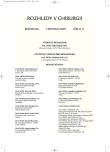Endoluminal Radiofrequency Ablation of Varices
Authors:
L. Hnátek; J. Duben; B. Dudešek; J. Gatěk
Authors‘ workplace:
Chirurgické oddělení Nemocnice ATLAS, a. s. Zlín, přednosta: prim. MUDr. J. Gatěk, Ph. D.
Published in:
Rozhl. Chir., 2007, roč. 86, č. 11, s. 582-586.
Category:
Monothematic special - Original
Overview
Introduction:
Chronic venous insufficiency affects a considerable proportion of the population and, commonly, is not considered a disease, but a disease process presenting as a wide range of clinical findings. The commonest findings include stages C2 and C3 according to the CEAP classification. Recently, modern miniinvasive surgical methods have come forth.
Aim:
The aim is to present the authorsę intitial experience with endoluminal bipolar radiofrequency thermotherapy of varices (RFITT).
Material, Methodology:
48 extremities operated in 35 subjects from January to June 2007. VSM (Vena saphaena magna) was operated in 47 cases and VSP (Vena saphaena parva) in a single case. Where terminal VSM valve insufficiency was detected, additional crossectomy was performed. In all subjects, the procedure was followed by mimiphlebectomy and foam sclerotherapy.
Results:
Obliteration of the operated vein using RFITT immediately after the procedure rated 100%. Subsequent recanalization was performed in a single subject after Day 140. Complications included irritation of the saphenous nerve in three subjects, in one case following miniphlegectomy and in the other two cases following RFITT. In all the subjects, the clinical findings recovered spontaneously within 14 days. Duration of their hospitalization was 5-24 hours.
Conclusion:
RFITT is a safe and effective miniinvasive surgical technique in the varicose veins management. It can be considered another alternative to other miinvasive procedures, such as laser endoluminal photocoagulation or conventional procedures, including stripping.
Key words:
radiofrequency ablation – varicose veins
Sources
1. Harnoss, B. M. Pilot study – Treatment of varicose veins using thermal occlusion. Martin-Luther-Hospital, Berlion, June, 2004.
2. Weiss, R. A., Weiss, M. A. Controlled radiofrequency endovenous occlusion using a unuque radiofrequency catheter under duplex guidance to eliminate saphenous varicose vein reflux: a 2-year follow-up. Dermatol. Surg., 2002; 38–42.
3. Lurie, F., Creton, D., Eklof, B., Kabnick, L. S., Kistner, R. L., Pichot, O., et al. Prospective randomized study of endovenous radiofrequency obliteration (closure procedure) venous ligation and stripping in a selected patient population (EVOLVeS Study). J. Vasc. Surg., 2003; 38: 207–214.
4. Rautio, T., Ohinmaa, A., Perala, J., Ohtonen, P., Heikkinen, T., Wiik, H., et al. Endovenou obliteration versus conventional stripping operation in the treatment of primary varicose veins: a randomized controlled trial with comparison of the cost. J. Vasc. Surg., 2002; 35: 958–965.
5. Wagner, W. H., Levin, P. M., Cossman, D. V., Lauterbach, S. R., Cohen, J. L., Farber, A. Early experience with radiofrequency ablation af the greater saphenous vein. Ann. Vasc. Surg., 2004; 18: 42–47.
6. Maeseneer, M. G. Strategies to minimize the effect of neovascularization at the saphenofemoral junction after great saphenous vein surgery: an overview. Phlebology Lymphology, 2006; 4: 207–212.
7. Gradman, W. S. Venoscopic oblitertion of varical tributaries using monopolar electrocautery. Primary report. J. Dermatol. Surg. Oncol., 1994; 20: 482–485.
8. Politowski, M., Zelanzy, T. Complications and dificulties in eleelectrocoagulation of varices of the lower extremities. Surgery, 1966; 59: 932–934.
9. Watts, G. T. Endovenous diatermy destruction of internal saphenous. Br. Med. J., 1972; 4: 53.
10. Puggioni, A., Kalra, M., Carmo, M., Mozes, G., Gloviczki, P. Endovenous laser therapy and radiofrequency ablation of the great saphenous vein: Analysis of early efficacy and complications. J. Vasc. Surg., 2005; 42: 488–493.
11. Schmedt, C.-G., Sroka, R., Steckmeier, S., Meisner, O. A., Babaryka, G., Hubger, K., Ruppert, V., Sadeghi-Azandaryani, M., Steckmeier Investigation on Radiofrequency and Laset (980nm) Effects after Endoluminal Treatment of Saphenous Vein Insufficiency. E. J. Vasc. Surg., 2006; 32: 318–325.
12. Mumme, A., Olbrich, S., Barbera, L., Stücker, M. Saphenofemorales Leistenrezidiv nach Stripping der Vena saphena magna: technischer Fehler oder Neovaskularisation? Phlebologie, 2002; 4: 38–41.
13. Leitlinien der Deutschen Gesellschaft für Phlebologie (DGP), der Deutschen Gesellschaft für Gefäßchirurgie, des Berufsverbandes der Phlebologen e.V. und der Arbeitsgemeinschaft der niedergelassenen Gefäßchirurgen Deutschlands e.V.; Zuletzt aktualisiert am 13. 11. 2006
Labels
Surgery Orthopaedics Trauma surgeryArticle was published in
Perspectives in Surgery

2007 Issue 11
Most read in this issue
- False Acute Large Bowel Obstruction
- Percutaneous vs. Open Repair of the Subcutaneous Achilles Tendon Rupture
- Laparoscopic Gastric Tubulization– Sleeve Gastrectomy – Another Option for Bariatric Food Intake Restriction in Morbidly Obese Subjects
- Endoluminal Radiofrequency Ablation of Varices
